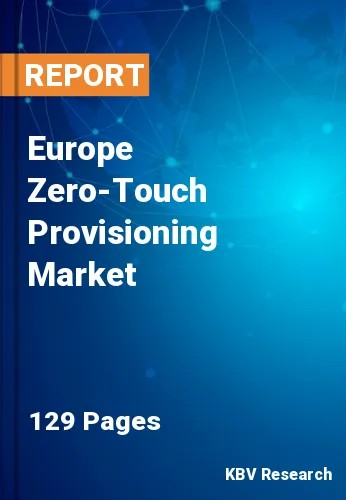The Europe Zero-Touch Provisioning Market would witness market growth of 9.6% CAGR during the forecast period (2022-2028).
ZTP reduces operational expenses, time devoted to manual labor, and human errors, which helps the market expand. Automation and removing errors are essential as data centers transition to dynamic cloud computing from static legacy networks. Networking equipment with ZTP capability facilitates deployment simplicity and minimizes provisioning errors.
There are numerous ways to apply ZTP. The network device must have access to the site where the configuration settings are kept in order to load and run them in each of the configuration scenarios. The most common approach is the DHCP method, which enables the distant device to connect to the DHCP server that allocates the device's IP address and identifies the server from which the device can get its configuration. The USB method enables deployment by executing a script from the device's built-in USB flash drive. Finally, the installation engineer can use the email-based method by clicking the URL provided to them in the email to go to a server where the script is downloaded into the CPE.
White box suppliers have been enabling ZTP for a while, while traditional switching suppliers are gradually moving their procedures over to it. Given that the white box often contains hardware from one vendor, an OS from some other vendor, and an application from yet another vendor, the efficiency of the system depends on how seamlessly all these components can be combined. Notably, zero-touch provisioning is extremely useful in these circumstances.
The regional market's rapid digitalization across all industries would be advantageous for IoT-related sophisticated solutions and technologies. Germany, the UK, Spain, France, Italy, and the Netherlands are leading the way in Europe regarding IoT adoption, but Eastern Europe and the Nordic countries aren't far behind. Therefore, to fully support an aspirational endeavor for joint work development in microelectronics related to connected automotive solutions, the European Commission (EC) announced that it had granted a sizeable sum of public financing from Germany, France, the United Kingdom, and Italy.
The Germany market dominated the Europe Zero-Touch Provisioning Market by Country in 2021; thereby, achieving a market value of $305.9 million by 2028. The UK market is exhibiting a CAGR of 8.7% during (2022 - 2028). Additionally, The France market would experience a CAGR of 10.4% during (2022 - 2028).
Based on Component, the market is segmented into Platform, and Services. Based on Network Complexity, the market is segmented into Complex Network Architecture, Dynamic Network Environment, and Multi-Vendor Environment. Based on Enterprise Size, the market is segmented into Large Enterprises, and Small & Medium Enterprises. Based on Device Type, the market is segmented into Routers & Switches, Access Points, Firewalls, IoT Devices, and Others. Based on Industry, the market is segmented into IT & Telecommunications, Manufacturing, Healthcare, Retail, and Others. Based on countries, the market is segmented into Germany, UK, France, Russia, Spain, Italy, and Rest of Europe.
Free Valuable Insights: The Global Zero-Touch Provisioning Market will Hit $4.7 Billion by 2028, at a CAGR of 10.1%
The market research report covers the analysis of key stake holders of the market. Key companies profiled in the report include Hewlett-Packard enterprise Company (HP Development Company L.P.), Nokia Corporation, Ericsson AB, Huawei Technologies Co., Ltd. (Huawei Investment & Holding Co., Ltd.), Extreme Networks, Inc., ZTE Corporation, Cisco Systems, Inc., Juniper Networks, Inc., Arista Networks, Inc. and Riverbed Technology, Inc. (Thoma Bravo)
By Component
By Network Complexity
By Enterprise Size
By Device Type
By Industry
By Country
Our team of dedicated experts can provide you with attractive expansion opportunities for your business.

